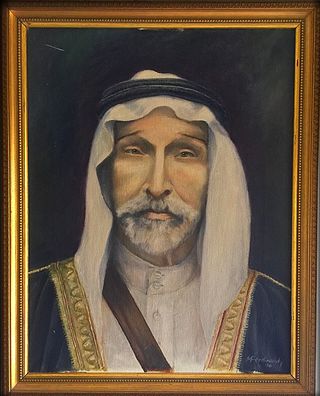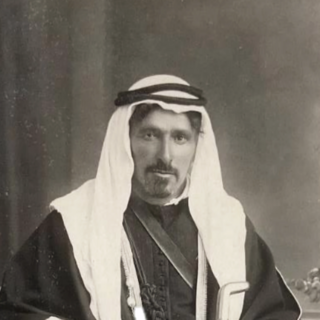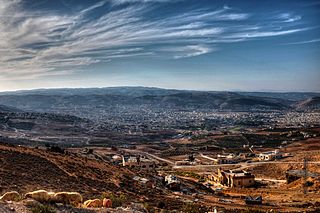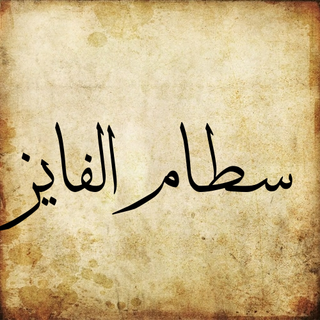
The history of Jordan refers to the history of the Hashemite Kingdom of Jordan and the background period of the Emirate of Transjordan under British protectorate as well as the general history of the region of Transjordan.

The Bedouin, Beduin, or Bedu are pastorally nomadic Arab tribes who have historically inhabited the desert regions in the Arabian Peninsula, North Africa, the Levant, and Mesopotamia. The Bedouin originated in the Syrian Desert and Arabian Desert but spread across the rest of the Arab world in West Asia and North Africa after the spread of Islam. The English word bedouin comes from the Arabic badawī, which means "desert dweller", and is traditionally contrasted with ḥāḍir, the term for sedentary people. Bedouin territory stretches from the vast deserts of North Africa to the rocky sands of the Middle East. They are traditionally divided into tribes, or clans, and historically share a common culture of herding camels and goats. The vast majority of Bedouins adhere to Islam, although there are some fewer numbers of Christian Bedouins present in the Fertile Crescent.

The Emirate of Transjordan, officially known as the Amirate of Trans-Jordan, was a British protectorate established on 11 April 1921, which remained as such until achieving formal independence in 1946.

As-Salt, also known as Salt, is an ancient trading city and administrative centre in west-central Jordan. It is on the old main highway leading from Amman to Jerusalem. Situated in the Balqa highland, about 790–1,100 metres above sea level, the city is built in the crook of three hills, close to the Jordan Valley. One of the three hills, Jabal al-Qal'a, is the site of a 13th-century ruined fortress. It is the capital of Balqa Governorate of Jordan.

The Ikhwan, commonly known as Ikhwan man ata'a Allah, was a religious militia made up of traditionally nomadic tribesmen which formed a significant military force of the ruler Ibn Saud and played an important role in establishing him as ruler of most of the Arabian Peninsula in the Kingdom of Saudi Arabia.

The Beni Sakhar confederacy is one of the largest and most influential tribal confederacies in Jordan. The Bani Sakher began migrating to Jordan as early as the 16th century and grew to become an influential tribe as by around the mid 18th century. According to the 1986 Jordanian Electoral Law, the Bani Sakher tribe is made up of fourteen clans: Al-Fayez; AL-Jahawsheh; Al-Khirshan; Al-Jbour; Al-Salim; Al-Badareen; Al-Gudah; Al-Hammad; Al-Shra'ah and Al-Zaben ; Al-Ghbein; Al-Amir; Al-Ka'abna; Al-Hgeish; Al-Saleet, and Al-Taybeen.

Ikhwan raids on Transjordan were a series of attacks by the Ikhwan, irregular Arab tribesmen of Najd, on Transjordan between 1922 and 1924. The repeated Wahhabi incursions from Najd into southern parts of his territory were the most serious threat to emir Abdullah's position in Transjordan. The emir was powerless to repel those raids by himself, thus the British maintained a military base, with a small air force, at Marka, close to Amman. The British military force was the primary obstacle against the Ikhwan, helping Emir Abdullah to secure his rule over Transjordan.
The Kura rebellion in Transjordan, April 1921, was instigated when Sheikh Kulaib al-Shraideh, a self-established ruler of the district of Kura, refused to surrender his autonomy to the adjacent district of Irbid. Shraideh’s motivations included personal hatred towards Ali Khulki Al-Sharayri, one of Emir Abdullah's ministers, who was head of the Irbid district. Shraideh demanded that the Kura be designated a separate entity, severed from Irbid, and answerable separately to Amman.

Mustafa Wahbi Tal, also known by his pen name Arar, was a Jordanian poet, writer, teacher and civil servant, widely regarded as Jordan's most prominent poet and among the best-known Jordanian poets among Arab readers.
The 1757 Hajj caravan raid was the plunder and massacre of the Hajj caravan of 1757 on its return to Damascus from Mecca by Bedouin tribesmen. The caravan was under the protection of an Ottoman force led by the Wali of Damascus, Husayn Pasha, and his deputy Musa Pasha, while the Bedouin were led by Qa'dan al-Fayez of the Bani Sakher tribe. An estimated 20,000 pilgrims were either killed or died of hunger or thirst as a result of the raid.

Haditha Ali Abdullah Al-Khraisha was a Jordanian Bedouin tribal sheikh. He was one of the two paramount sheikhs of the Bani Sakhr Tribe, arguably the most powerful tribe in Jordan. Haditha headed the northern clans of the Bani Sakher (al-Ka'abnah), while Mithgal Al-Fayez headed the other half, (al-Twaga). In the early twentieth century, Haditha and the Bani Sakhr, in addition to other Trans-Jordanian tribes such as the Huweitat and the Belqawiah, fought the Wahhabi Ikhwan, a religious militia who helped establish Abdul Aziz Ibn Saud as the first King of Saudi Arabia. The Wahhabi Ikhwan were Abdul Aziz Ibn Saud's tool for territorial expansion and lent religious legitimacy to Ibn Saud's territorial and political ambitions. According to King Faisal Al Saud the armed resistance that Bani Sakhr put up against Ibn Saud and the Wahhabi Ikhwan was "the reason that Saudi Arabia's borders do not extend all the way to Palestine and why the Al Sauds never became the rulers of the Levant". Haditha was known throughout Arabia for his wisdom and chivalry, He played a significant role in building the nascent Jordanian state and shaping its development. An ally and supporter of King Abdullah I, Haditha served several terms as Senator and Parliamentarian, including the first Jordanian Senate in 1947 which consisted of only ten members. Haditha was also elected to the second Legislative Council in June 1931, and the Fourth Legislative Council in 1937 while Jordan was still an Emirate. Haditha was also one of the founding members of the Jordanian Solidarity Party in March 1933. Sheikh Haditha also cultivated the oasis of Azraq, Jordan.

Mithqal Sattam Fendi Al-Fayez (Arabic: مثقال الفايز, was a historical Jordanian political and tribal figure whose work helped the establishment of The Hashemite Kingdom of Jordan. Mithqal was one of the two leading sheikhs of Bani Sakhr; he took power in the early twentieth century, and headed the Bani Sakhr tribe generally and the Al-Twaga half of the tribe specifically, which consisted of the four major clans, Al Ghbeyen, Al Ghuful, Al A'lqam, and Al Tabab, which comprise of 32 sub-clans which further divide into more sub-clans. He also headed his own clan, Al-Fayez.

The Balqa, known colloquially as the Balga, is a geographic region in central Jordan generally defined as the highlands east of the Jordan Valley in between the Zarqa River to the north and the Wadi Mujib gorge to the south.

Establishment of the Emirate of Transjordan refers to the government that was set up in Transjordan on 11 April 1921, following a brief interregnum period.

Circassians in Jordan are Circassians living in Jordan. Circassian refugees arrived in Jordan in the late 19th century, after being exiled during the Circassian genocide in the 1860s and later the Russo-Turkish War (1877–1878). They settled in Jordan, then a part of Ottoman Syria, in and around Amman and Jerash. Circassians are credited with founding modern Amman as the city had been previously abandoned.
The House of Fayez(Arabic: الفايز or, colloquially: Al-Fayez, Alfayez, Al Fayez, Al Faiz, Al Fayiz) is a noble sheikhly Jordanian family that heads the major Jordanian clan Bani Sakher. The family's influence and prominence in the region was at its ultimate under Fendi Al-Fayez, who led the family in the 1840s and gradually became the leader of the entire Bani Sakher. Fendi would rule large parts of Jordan and Palestine, including the ancient Kingdoms of Moab and Ammon, and parts of modern-day Saudi Arabia until the late 1860s when a series of battles with the Ottoman Empire decreased the family's resources and claimed a portion of its holdings. After Fendi, his young son Sattam led the tribe in a push to cultivate the lands and live a more sedentary lifestyle, then under Mithqal Alfayez as a permanent political power in modern Jordan. The family was the largest owner of land in Jordan and owned portions of modern day Palestine, and Mithqal was the single largest owner of private land in the kingdom in 1922. The Al-Fayez family is active in Jordanian and Arabian politics and is currently headed by former Prime Minister Faisal Al-Fayez.

Akef Mithqal Al-Fayez was a Jordanian politician born in Amman, Jordan. He held several ministerial positions and became speaker of the Jordanian Parliament for several sessions and a member of the Jordanian Senate.

Fendi Abbas Awad Al Fayez was an Arab leader from the Al-Fayez family who was the chief Sheikh of the Bani Sakher Clan from the 1820s up until his death. He is widely regarded as the most influential figure in the Bani Sakher and one of the most powerful tribal figures in Arabia in the 19th century. Fendi's first documented tribal battle was as early as 1820 when he was just twenty years old.

Sattam Fendi Abbas Al Fayez (Arabic: سطام الفايز, was an emir who led the Bani Sakher tribe from 1881 until his death in 1891. He was the de facto ruler of the Bani Sakher after his father Fendi Al-Fayez gave him most of his responsibilities in the late 1870s, and was the first person to have led Westerners to view the Moabite Stone in 1868. Sattam was also the first tribal sheikh to begin cultivating land in the 1860s, which began the sedentary settlement process of many of the biggest tribes in Jordan. In September 1881, after the reunification of the Al-Fayez family under Sattam, he was recognized by the Ottoman Administration as the Emir of Al-Jizah and the paramount Shaykh of the Bani Sakher clan.
Sheikha Al Anoud bint Dahham Al Fayez is a Jordanian noblewoman and former Saudi royal. She is the daughter of one of the sheikhs of the Al-Fayez clan from Bani Sakher, Sheikh Daham bin Dardah Al-Bakhit Al-Fayez and his wife Gutnah bint Mithqal Pasha Al-Fayez, daughter of the paramount Sheikh of the Bani Sakher. She was the wife of King Abdullah bin Abdulaziz Al Saud from 1972 to 2003 following a divorce. She is the mother of four daughters: Jawaher, Hala, Maha, and Sahar Al-Saud.















